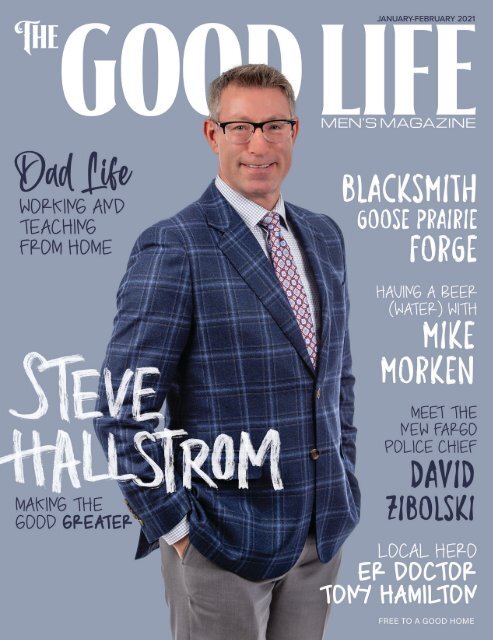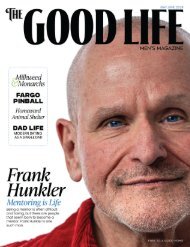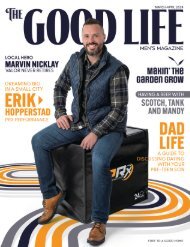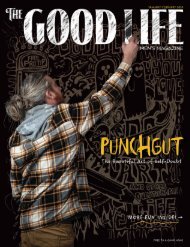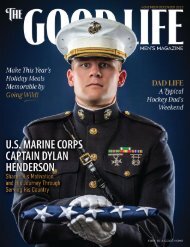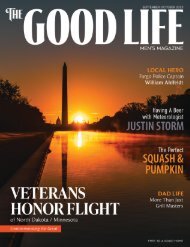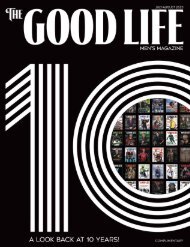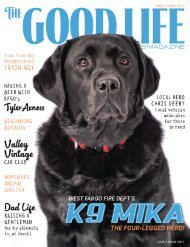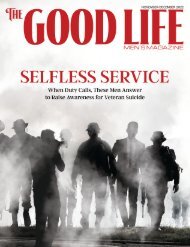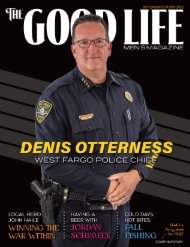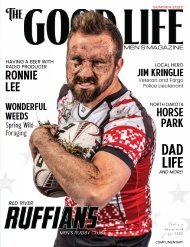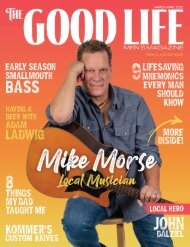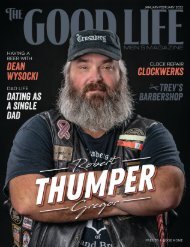The Good Life – January-February 2021
On the cover – Steve Hallstrom - Radio Host and President of Flag Family Media. Local Hero – Tony Hamilton - Emergency Room Physician. Dad Life – Working and Teaching from Home. Fargo's new Police Chief and more in Fargo-Moorhead’s only men’s magazine.
On the cover – Steve Hallstrom - Radio Host and President of Flag Family Media. Local Hero – Tony Hamilton - Emergency Room Physician. Dad Life – Working and Teaching from Home. Fargo's new Police Chief and more in Fargo-Moorhead’s only men’s magazine.
You also want an ePaper? Increase the reach of your titles
YUMPU automatically turns print PDFs into web optimized ePapers that Google loves.
<strong>The</strong> Flow of the River<br />
WRITTEN BY: JEFFREY MILLER • PHOTO BY: URBAN TOAD MEDIA<br />
During the winter season of snow<br />
and ice, it's easy to forget about<br />
rivers. In the Red River Valley, rivers<br />
are often only thought of in the<br />
context of spring flooding. That's<br />
unfortunate because the rivers<br />
around us are amazing natural<br />
resources!<br />
ThE RIVERS<br />
AROUND US ARE<br />
AMAZING NATURAL<br />
RESOURCES!<br />
<strong>The</strong> area's largest river, the Red<br />
River, is unique in the fact that it<br />
flows north to its terminus. Formed<br />
2 / THE GOOD LIFE / urbantoadmedia.com<br />
after the giant glacial Lake Agassiz<br />
drained 9,500 years ago, the Red<br />
River watershed is over 40,000<br />
square miles in size. Many small<br />
rivers, such as the Sheyenne,<br />
the Maple and the Wild Rice on<br />
the North Dakota side, and the<br />
Buffalo and Red Lake River on the<br />
Minnesota side, empty into the Red.<br />
Unfortunately, many people think<br />
our prairie rivers are dirty and<br />
polluted. While it is true that they<br />
aren't crystal clear, the opaqueness<br />
comes from suspended silt in the<br />
water. As the Red flows through the<br />
bottom of Glacial Lake Agassiz, the<br />
soil is clay, consisting of very fine<br />
particles. In moving water, these<br />
particles stay suspended, coloring<br />
the water brown.<br />
Beyond getting our drinking water<br />
from the Red River, it also provides<br />
a fantastic habitat for a wide variety<br />
of wild critters. <strong>The</strong> forest growing<br />
near the river is known as a riparian<br />
forest. Prior to settlement, the<br />
only trees growing in the prairie<br />
were along the rivers and streams.<br />
While small, these forests have a<br />
staggering amount of biodiversity.<br />
While it's easy to see deer and bald<br />
eagles, all kinds of animals make<br />
their home in the riparian forests.<br />
<strong>The</strong>re are even some modern-day
wildlife success stories playing out near the river.<br />
Fisher and river otter, animals that haven't been<br />
seen in many years, now have breeding populations.<br />
Nature is resilient, filling all available ecological<br />
niches.<br />
Unfortunately, our rivers face obstacles. Run-off, both<br />
from urban areas and rural areas, dump fertilizers<br />
and other contaminants in the water. In the past, it<br />
has been easy to point fingers at who is causing the<br />
most issues with runoff. We've come to realize that<br />
all runoff contributes to nutrient overload.<br />
<strong>The</strong>re are many ways we can protect our waters<br />
from runoff. Reducing the use of fertilizers and<br />
pesticides can help with point-source runoff. Before<br />
applying fertilizer to your lawn or garden, read the<br />
instructions on the bag. It's easy to think that more<br />
fertilizer means better plants, that is not the case.<br />
What isn't used by the soil and plants will wash off,<br />
increasing the nutrient load of the waterways as well<br />
as wasting your money.<br />
Planting perennial grasses and trees also helps<br />
stem runoff. Exposed soil or short grass near<br />
waterways allowing both nutrient and soil to wash<br />
into the water. By leaving a buffer of tall grass<br />
or trees and shrubs along the bank that runoff is<br />
captured. <strong>The</strong> vegetation also helps in stabilizing<br />
the bank. Excessive erosion can endanger roads,<br />
properties and homes. <strong>The</strong> roots of perennial<br />
vegetation, especially native grasses, flowers and<br />
trees, hold the soil in place.<br />
I'm always amazed at the flow of traffic east into<br />
Minnesota Lakes country each weekend in the<br />
summer. While that area is beautiful and full of<br />
recreational opportunities, the Red River also<br />
offers nearly untapped resources. Kayaking,<br />
canoeing and hiking can all be enjoyed around<br />
the metro area. In addition, the Red River offers<br />
fishing opportunities for world-class channel cat.<br />
Reeling in a twenty-pound catfish is not for the<br />
faint of heart!<br />
As a community, we need to work hard to protect<br />
our river resources. <strong>The</strong> Cass County Soil<br />
Conservation District can help with a variety of<br />
measures to protect the river. We offer cost-share<br />
for a variety of management practices as well as<br />
technical assistance. <strong>The</strong>re is even a watershed<br />
project area, funded through the EPA 319 program,<br />
for the Maple River Watershed. Contact us today to<br />
find out how we can help! •<br />
urbantoadmedia.com / THE GOOD LIFE / 3
JANUARY-FEBRUARY <strong>2021</strong><br />
VOLUME 8 • ISSUE 4<br />
THE FLOW OF THE RIVER<br />
A PROFESSION OF PURPOSE<br />
Fargo's New Police Chief Ready to<br />
Make a Difference<br />
FATHERS - DAD LIFE<br />
Working and Teaching from<br />
Home: A Timeline<br />
GOOSE PRAIRIE FORGE<br />
Home to Passion and<br />
Precision<br />
MEN'S HEALTH<br />
<strong>2021</strong> Goal: Focus on the<br />
Journey<br />
ON THE COVER<br />
Making the <strong>Good</strong> Greater<br />
Steve Hallstrom’s Journey<br />
from the Farm to <strong>The</strong> Flag<br />
PEOPLE'S HOME EQUITY<br />
Local Lender's Mission to<br />
Serve<br />
HAVING A BEER WITH<br />
Having a Beer (Water) with<br />
Mike Morken<br />
4 / THE GOOD LIFE / urbantoadmedia.com<br />
LOCAL HERO<br />
Tony Hamilton - Emergency<br />
Room Physician
PUBLISHED BY<br />
Urban Toad Media LLP<br />
www.urbantoadmedia.com<br />
OWNER / GRAPHIC DESIGNER<br />
Dawn Siewert<br />
dawn@urbantoadmedia.com<br />
OWNER / PHOTOGRAPHER<br />
Darren Losee<br />
darren@urbantoadmedia.com<br />
CONTRIBUTING WRITERS<br />
Meghan Feir<br />
Paul Hankel<br />
Ben Hanson<br />
Jeffrey Miller<br />
Krissy Ness<br />
Emma Vatnsdal<br />
ADVERTISING INQUIRIES<br />
Darren Losee<br />
darren@urbantoadmedia.com<br />
READ A PAST ISSUE<br />
yumpu.com/user/thegoodlife<br />
FOLLOW US ON FACEBOOK<br />
facebook.com/urbantoadmedia<br />
FOLLOW US ON TWITTER<br />
@urbantoadmedia<br />
FOLLOW US ON INSTAGRAM<br />
@urbantoadmedia<br />
<strong>The</strong> <strong>Good</strong> <strong>Life</strong> Men’s Magazine is distributed six times a year<br />
by Urban Toad Media LLP. Material may not be reproduced<br />
without permission. <strong>The</strong> <strong>Good</strong> <strong>Life</strong> Men’s Magazine accepts<br />
no liability for reader dissatisfaction arising from content in<br />
this publication. <strong>The</strong> opinions expressed, or advice given,<br />
are the views of individual writers or advertisers and do not<br />
necessarily represent the views or policies of <strong>The</strong> <strong>Good</strong> <strong>Life</strong><br />
Men’s Magazine.<br />
urbantoadmedia.com / THE GOOD LIFE / 5
Before his first day began at the Fargo Police Department<br />
on Oct. 5, 2020, Chief David Zibolski had served the state<br />
of Wisconsin for 36 years, promoting positive change in<br />
communities across the state. Immediately prior to his role<br />
in Fargo, he served as chief of police for the Beloit Police<br />
Department in Beloit, Wisc.<br />
No stranger to high-tension situations, Zibolski started his<br />
role at the Beloit Police Department in 2015 in a rushed<br />
fashion after the city’s previous chief and deputy chief were<br />
walked out abruptly and later resigned after an internal<br />
investigation.<br />
“I kind of came into that position in the<br />
midst of a crisis,” Zibolski said. “<strong>The</strong>y<br />
were looking for someone to come into a<br />
leadership position and essentially take<br />
over and turn the department in a better<br />
direction with very little notice, so that<br />
was a pretty big challenge.”<br />
Over the course of his five years<br />
in Beloit, a lot was accomplished.<br />
Policies were set in place to protect<br />
both officers and community<br />
members, violent crimes were<br />
reduced, and the department greatly<br />
improved their training programs.<br />
“It is very different than when I took<br />
over, and it’s not just my efforts. It’s the<br />
efforts of the personnel working there,”<br />
Zibolski said. “Most of the people in law<br />
“I think my experience in<br />
Milwaukee really gave me a lot<br />
of background and experience.<br />
It was a very busy department<br />
and a very diverse city, and<br />
going to the Department of<br />
Justice provided some of that<br />
statewide and legislative<br />
perspective.” <strong>–</strong> Chief Zibolski
WRITTEN BY: MEGHAN FEIR • PHOTOS BY: URBAN TOAD MEDIA<br />
enforcement are there because of their passion to serve<br />
and their understanding of the importance of the role in<br />
society. It’s getting the right people in place, giving them<br />
guidance and leadership and then letting them go out<br />
and do what they need to do.”<br />
Even before Beloit, Zibolski had always served in<br />
Wisconsin. A born-and-raised Wisconsinite, he started<br />
his career in Milwaukee. For 27 years, he was a part of<br />
their police department where he worked his way up<br />
through the ranks in various divisions and bureaus.<br />
In 2011, he retired as a captain and took up a position<br />
with the Wisconsin Department of Justice as a deputy<br />
administrator for the Division of Law Enforcement<br />
Services, a statewide agency that oversees law<br />
enforcement training and standards for the entire state.<br />
That’s not a small undertaking. In Wisconsin alone,<br />
there are 16,000 cops and around 600 agencies.<br />
Zibolski also oversaw Wisconsin’s Crime Laboratory<br />
Bureau, Crime Information Bureau and the Bureau of<br />
Justice Information and Analysis.<br />
“It was a statewide law enforcement position, along with<br />
a lot of legislative efforts. We were able to successfully<br />
pass some bills that enhanced law enforcement training,”<br />
Zibolski said. “I think my experience in Milwaukee<br />
really gave me a lot of background and experience. It<br />
was a very busy department and a very diverse city, and<br />
going to the Department of Justice provided some of<br />
that statewide and legislative perspective.”<br />
A new state of being<br />
When the five years came to an end at Beloit, Zibolski<br />
wanted to continue expanding his career opportunities<br />
and began looking for a larger organization. With family<br />
in Montana, he wanted to stay in the Midwest. That’s<br />
when Fargo popped up on the radar.<br />
“I didn’t really know much about Fargo. My wife and I<br />
did a little research and came to check it out. We really<br />
were impressed with the city,” Zibolski said. “<strong>The</strong>re’s so<br />
much here and so much to do. <strong>The</strong> growth, the way in<br />
which it’s managed and the people here were all very<br />
impressive, so we went through the process and it<br />
fortunately was successful.”<br />
While his first few months have been extremely busy<br />
meeting personnel and learning about Fargo’s operations,<br />
he’s also starting to plan for the department’s future as<br />
he contemplates enhancements and evaluates the whole<br />
organization’s procedures, policies and responsibilities.<br />
“It’s been a pretty busy first few months, but it’s going<br />
very well. <strong>The</strong> job is challenging, but it’s rewarding and<br />
I’m enjoying that.”<br />
Overcoming the challenges<br />
With the current climate of discontent in the nation,<br />
this is one of the strangest and most difficult times to<br />
be a part of a police department, but people like Chief<br />
Zibolski are always up for the challenge. He believes<br />
those who really want to be community servants<br />
will continue to become officers.<br />
urbantoadmedia.com / THE GOOD LIFE / 7
“It is an interesting period and rather difficult from a<br />
community relations perspective. Along with COVID,<br />
the culmination of those two things has made a difficult<br />
job twice as difficult and challenging as it was before<br />
for both being a chief and a police officer,” Zibolski<br />
said. “I think the success of law enforcement in general,<br />
especially the success of folks here in Fargo, is a tribute<br />
to their resiliency. Even though they have to do things<br />
differently and we have to take precautions we wouldn’t<br />
normally have to take, they’re still out there every day<br />
doing their job. That’s what’s important. Certainly the<br />
community expects that, even when things are difficult.”<br />
According to one survey by the Police Executive Research<br />
Forum taken in 2020, of the agencies that participated<br />
in the survey, there was a 63 percent decrease in<br />
applications to become police officers, along with early<br />
exits and retirement rates growing higher across the<br />
country. <strong>The</strong>re are, of course, differences among each<br />
city and department, but nationally, the trend is quite<br />
clear.<br />
“It’s much more difficult now, but we’ve been pretty<br />
successful,” Zibolski said, “Last year, our staff put<br />
together the first academy ever. It was very successful.<br />
We have a group of individuals who are interested in<br />
joining the department and they’ve already been through<br />
the initial training. From that perspective, I think we<br />
really have both feet in front of the game, and I think<br />
that’s good for us and our community.”<br />
Promoting the good life<br />
In order to create better lives for officers and members<br />
of the community, Chief Zibolski is hoping to create a<br />
more efficient staffing schedule that will also create a<br />
healthier work-life balance for the officers in Fargo. He<br />
says this will not only make more sense in balancing<br />
busier with slower times, but also in creating more<br />
opportunities for positive community engagement for all<br />
the officers.<br />
“<strong>The</strong>re are a lot of great, committed officers here. We<br />
have a community engagement team that’s engaging our<br />
8 / THE GOOD LIFE / urbantoadmedia.com
community on a regular basis, but most people<br />
also want to know their beat officers and they<br />
want to have those positive interactions with<br />
the other officers who work here. <strong>The</strong> current<br />
schedule doesn’t necessarily allow them to do<br />
that because they’re busy going from call to<br />
call,” Zibolski said. "When you’re dealing with<br />
mostly negative types of things, it’s nice to have<br />
that positive interaction. Obviously COVID has<br />
affected events and engagement, but I think we’re<br />
doing our best to work around that and create<br />
some different engagement opportunities.”<br />
As far as how Zibolski views how to live the good<br />
life himself, finding fulfillment in every area of life<br />
tops the list.<br />
“I think you have to be happy on a personal<br />
level. You want to have a career that’s fulfilling,<br />
rewarding and has purpose, and you also want to<br />
have a personal life that has those same things,”<br />
Zibolski said. “When I stop enjoying doing what<br />
I’m doing, I’ll know it’s probably time for me to<br />
retire and find something else. You can’t come to<br />
a job like this and not be committed, passionate<br />
and positive about it. I think that’s very important<br />
for mental health, longevity and living the good<br />
life.” •<br />
urbantoadmedia.com / THE GOOD LIFE / 9
FATHERS | DAD LIFE<br />
Working and Teaching from Home: A Timeline<br />
WRITTEN BY: PAUL HANKEL • PHOTO BY: SOLEN FEYISSA<br />
9:00 am - Online Learning Time<br />
Tell your child that you don’t care that the video game<br />
he’s playing is live and that he supposedly can’t quit in<br />
the middle of a match. It's time to LEARN.<br />
Tell your child that we don’t call people names in this<br />
family.<br />
Boot up the laptop and attempt to sign in to your child’s<br />
distance learning portal.<br />
Swear, because you forgot your login and password.<br />
Remind your child that we don’t swear in this household.<br />
Contact your child’s school to retrieve your login<br />
credentials, only to find out that the school technology<br />
officer only works Tuesdays and Thursdays from 7 am -<br />
9 am, due to COVID. What?<br />
Begrudgingly reset your password, using a combination<br />
of at least ten characters, two capital letters, two<br />
Egyptian hieroglyphic symbols, and one drop of blood<br />
from a freshly sacrificed lamb.<br />
Glance over your child’s lesson plan.<br />
Regret sleeping through most of your high school and<br />
college classes.<br />
11:30am - Lunchtime<br />
Offer your child a well-rounded meal, featuring a protein,<br />
complex carbohydrate, and vegetable.<br />
Explain to your child that this isn’t a three-star Michelin<br />
restaurant or a hipster bistro and that you’re not taking<br />
menu requests.<br />
10 / THE GOOD LIFE / urbantoadmedia.com
Remind your child that we don’t call names in this<br />
house.<br />
Console your child.<br />
Try to sneak into your office for a quick work call<br />
while your child is begrudgingly eating their, “super<br />
gross,” lunch.<br />
Be interrupted on said work call because, “the<br />
peas touched the fish sticks,” and now your child<br />
can’t eat them.<br />
Remind your child that this isn’t a hotel and that<br />
he’s fully capable of bringing his dishes to the sink.<br />
12:00pm - Naptime<br />
Verbally and physically wrestle with your child,<br />
while explaining the importance of naptime.<br />
After 15 minutes of arguing, settle on an “openeyed<br />
rest,” in lieu of an actual nap.<br />
1:30pm - Recess<br />
No, playing Madden 20 does not count as physical<br />
activity, even though it’s a sport.<br />
Partake in a myriad of backyard physical activities<br />
until back sweat becomes an issue and you almost<br />
tear a rotator cuff trying to relive your high school<br />
glory days on the gridiron.<br />
2:15pm - Creative / Art Time<br />
Instantly regret agreeing to any glitter - or sand -<br />
related artwork projects.<br />
Settle for a Youtube fingerpainting tutorial.<br />
Sneak in a quick conference call, only to be<br />
interrupted again because your child ran out of<br />
blue paint.<br />
3:00 pm - Music Time<br />
Silently curse your child’s aunt for giving him a<br />
recorder for Christmas.<br />
Consider having music time outside going forward.<br />
Remember that you live in North Dakota and it’s<br />
<strong>January</strong>.<br />
3:30pm - End of Day<br />
Relent and let your child have tablet time.<br />
Make a mental note to post to social media about<br />
the fact that teachers are MASSIVELY underpaid.<br />
Open a bottle of wine. •<br />
urbantoadmedia.com / THE GOOD LIFE / 11
WRITTEN BY: KRISSY NESS<br />
PHOTOS BY: URBAN TOAD MEDIA<br />
Goose Prairie Forge<br />
home to passion and precision<br />
You may or may not be surprised<br />
to find that just north of Hawley,<br />
Minnesota tucked away on a farm,<br />
you will find master blacksmith,<br />
Douglas Swenson.<br />
Swenson has had a passion for<br />
blacksmithing since he was a small<br />
child.<br />
"My dad had taken a piece of<br />
equipment to be repaired by a<br />
blacksmith and he had taken me<br />
with that day. I just remember going<br />
into the shop seeing all of the activity<br />
that was going on at that point.<br />
<strong>The</strong>re was a fire going in the forge<br />
and the blacksmith was pulling some<br />
piece of hot iron out of the fire that<br />
"i remember the<br />
bright color<br />
of the fire and<br />
the sound of<br />
the hammer on<br />
the anvil; that<br />
was just very<br />
impressive to me."<br />
<strong>–</strong> Douglas<br />
swenson<br />
he was working on, hammering it<br />
on the anvil. I remember the bright<br />
color of the fire and the sound of the<br />
hammer on the anvil; that was just<br />
very impressive to me," remarked<br />
Swenson.<br />
Throughout the years, he has<br />
progressed in the art of blacksmithing<br />
not only by practicing but also by<br />
taking the time to get to know former<br />
blacksmiths from years past.<br />
"I did have the opportunity, many<br />
years ago, to visit some of the<br />
smaller community shops here in the<br />
area when they existed," mentioned<br />
Swenson. "I was also able to interview<br />
some of the existing blacksmiths that<br />
12 / THE GOOD LIFE / urbantoadmedia.com
urbantoadmedia.com / THE GOOD LIFE / 13
were just finishing their careers in<br />
those shops. I was very fortunate<br />
that I took the time back then to find<br />
these people and visit with them; it<br />
gave me a good feeling of what shops<br />
were like, what equipment they used,<br />
how they worked, and the type of<br />
work they did."<br />
He has a shop on his farm that<br />
recreates the 1895-1910 era of<br />
blacksmithing.<br />
"It is geared towards what you<br />
would have seen in most of the small<br />
rural community blacksmith shops<br />
around the turn of the century,"<br />
stated Swenson. "I chose that period<br />
because here, in the Red River Valley,<br />
14 / THE GOOD LIFE / urbantoadmedia.com<br />
that was a time of very rapid growth<br />
and expansion."<br />
His shop is set up so all of the tools<br />
and equipment are from that period<br />
that he has collected and he tries to<br />
use the same type of work methods<br />
that they would have 100 years ago.<br />
"It has always had kind of a special<br />
feeling to me, that period of time,"<br />
noted Swenson.<br />
Fortunately, Swenson's passion<br />
has provided for him and his family<br />
financially as well.<br />
"<strong>The</strong> majority of my time in the<br />
past two years, as far as the shop is<br />
concerned, has been spent teaching<br />
classes," stated Swenson. "I teach<br />
classes out of my shop directly;<br />
currently I have 8 individuals who<br />
come out for private instructions."<br />
Setting up an appointment for<br />
private classes is very simple; you<br />
can contact Swenson through his<br />
Facebook page, Goose Prairie Forge.<br />
He is very flexible when it comes<br />
to scheduling time to visit his shop;<br />
whether it is during the week or on<br />
the weekend he can find a time that<br />
works best for your schedule.<br />
Don't think that this is all that<br />
Swenson does when it comes to<br />
blacksmithing. Currently, he is
on staff at North House Folk School in Grand Marais,<br />
Minnesota, the Vesterheim in Decorah, Iowa, and Aspire<br />
Artisan Studio and Folk School in Waconia, Minnesota.<br />
But, wait, there is more! In addition to his shop and<br />
staffed positions, Swenson has studied under some of the<br />
most impressive blacksmiths around. He has studied in<br />
California, England, and Sweden.<br />
"I have learned a tremendous amount from those people<br />
which has been very helpful," said Swenson.<br />
More recently he has been awarded a grant from the<br />
American Scandinavian Foundation to return to Sweden<br />
and study further later in <strong>2021</strong>. He is the real deal when it<br />
comes to being a master blacksmith in the United States.<br />
Because kids are not in school right now due to quarantine,<br />
younger individuals, junior high to high school students,<br />
have set up times to come to visit Swenson's shop as a part<br />
of their homeschooling curriculum. This is such a clever<br />
way to get in a little extra history, creativity, and manual<br />
activity forging and creating.<br />
"I have a large shop and it has good ventilation. Usually, we<br />
have individuals, or a couple, or a family group, so we don't<br />
mix a lot of the public in the shop at this point," mentioned<br />
Swenson.<br />
It has to be so rewarding to come with a design in mind<br />
and execute it with a professional. I spoke with Swenson<br />
about setting up some time in the future to visit his shop<br />
and make something; a fire poker or dinner bell perhaps,<br />
or maybe both!<br />
"I think it is satisfying for people to be able to do that, to<br />
make a finished product," said Swenson.<br />
If you are curious to see what Swenson's work is all about,<br />
head over to his Facebook page at Goose Prairie Forge,<br />
and browse around for a while. You, too, will be captivated<br />
by the sights and sounds of his shop. •<br />
urbantoadmedia.com / THE GOOD LIFE / 15
MEN'S HEALTH<br />
WRITTEN BY: BEN HANSON<br />
<strong>The</strong> Importance of Finding<br />
Pleasure in New Habits<br />
Let's all join together, take a<br />
collective sigh of relief, and<br />
celebrate making it through 2020.<br />
It was not an easy year. In fact,<br />
for many of us, it was the most<br />
challenging year yet. But with the<br />
flip of the calendar, we are all given<br />
the chance at a restart — whatever<br />
your particular new start might<br />
look like.<br />
For the purposes of this column,<br />
however, we're going to assume<br />
many of you have a health and<br />
fitness-related goal. Whether it's<br />
weight loss, shaving some inches<br />
off your waistline, or finally diving<br />
into that Whole 30 cookbook you<br />
got as a not-so-subtle gift from your<br />
mother-in-law, New Year's fitness<br />
goals are as common as a Red River<br />
Flood. Though, we seem to battle<br />
floodwaters much more effectively<br />
than we battle the bulge.<br />
With the ongoing COVID-19<br />
pandemic still raging, there really<br />
is no better time than now to give<br />
your body and your brain the stress<br />
relief they so desperately need.<br />
COVID makes the logistics a bit<br />
tougher, but exercising during times<br />
of high stress is a proven method<br />
16 / THE GOOD LIFE / urbantoadmedia.com<br />
for boosting your overall mental<br />
well-being. You're going to have to<br />
plan. You're going to have to make<br />
room in your calendar and make<br />
it a priority. And to help maximize<br />
your initial excitement, it's good to<br />
understand why you may have failed<br />
in the past… and the super simple<br />
secret is to long-term success.<br />
Wrong Goals Lead to<br />
Failure<br />
Speaking with Dr. Forrest Sauer,<br />
Founder of Twin Oaks Health in<br />
Fargo, the reason why so many of<br />
us end up failing to reach our New<br />
Year's resolution goals isn't so<br />
much that we lack commitment or<br />
ability, but we always tend to focus<br />
our energies and optimism on the<br />
wrong thing.<br />
"Oftentimes people will only find<br />
pleasure in the end result… hitting<br />
the number on the scale or getting<br />
the six-pack or whatever it is,"<br />
Dr. Sauer explained. "All of your<br />
emotion and mindset is on that<br />
goal, but that is such a fleeting and<br />
very shallow approach to getting<br />
in shape, because once you've<br />
achieved it you're done. You hit<br />
that peak rush… but then what?<br />
Inevitably, after that huge high<br />
you suffer a very quick emotional<br />
drop with nothing left to keep you<br />
motivated."<br />
Train Your Brain to Love<br />
the Work<br />
When it comes to long term weight<br />
loss or fitness success, maintenance<br />
is the name of the game… and it's a<br />
long game. Your goal may be to lose<br />
20 pounds, but that's just one goal<br />
on the long road to lifetime healthy<br />
weight maintenance. In order to<br />
achieve that, you've got to find a<br />
way to fall in love with the work<br />
that's required. That work needs to<br />
become a habit.<br />
"<strong>The</strong> trick is to find pleasure in the<br />
act of getting there," Dr. Sauer said<br />
bluntly. "You gotta force yourself<br />
to enjoy exercising — it's a mental<br />
discipline at the end of the day, and<br />
you can train your brain at this just<br />
as you train the rest of your physical<br />
body.<br />
<strong>The</strong> reward is that wonderful<br />
dopamine rush that comes with<br />
physical exertion, Dr. Sauer<br />
explained. He says you can train<br />
your brain to like exercise — and<br />
learn to love it — by connecting<br />
those feelings of pleasure with the<br />
action itself vs. the result in the<br />
mirror or on the scale.
"<strong>The</strong> more you love the lifting,<br />
the running or healthy dietary<br />
choices, the more likely you are<br />
to maintain those actions," he<br />
said. "It's pretty neat, because<br />
really what you're doing at a<br />
scientific level is changing the<br />
chemistry in your brain to keep<br />
you motivated. Clients that<br />
suffer from mood disorders like<br />
depression can do the same<br />
thing."<br />
At Twin Oaks, Dr. Sauer and<br />
his team focus on these highlevel<br />
changes to help their<br />
clients achieve lasting success.<br />
<strong>The</strong>ir goal is to hold people<br />
accountable by showing them<br />
exactly what they need to do<br />
given their specific goals and<br />
specific body types. It's not all<br />
calorie counting and reps on the<br />
weight bench. "For example,"<br />
Dr. Sauer said, "if you want to<br />
lose 50 pounds, but we uncover<br />
you suffer from a hormonal<br />
imbalance, we have to do certain<br />
things first to address that<br />
before we can focus on a weight<br />
loss program that is going to<br />
last." •<br />
Special thanks to Dr. Forrest Sauer at<br />
Twin Oaks Health Solutions, medical<br />
consultant for our Men's Health section.<br />
urbantoadmedia.com / THE GOOD LIFE / 17
ON THE COVER | STEVE HALLSTROM<br />
MAKING THE GooD<br />
GREATER<br />
Steve Hallstrom’s Journey from the Farm to <strong>The</strong> Flag<br />
WRITTEN BY: MEGHAN FEIR<br />
PHOTOS BY: URBAN TOAD MEDIA<br />
Throughout his career, Steve Hallstrom, the managing<br />
partner, radio host and president at Flag Family Media,<br />
has played many parts. Over the past 30 years, he’s worked<br />
on a farm, managed a grain elevator, sold Billy Graham<br />
videos to churches, worked as a mortgage lender and been<br />
a sports broadcaster on TV, along with other roles that only<br />
add to the diversity of dexterities displayed on his resume.<br />
Whatever new responsibility he takes on, one thing<br />
remains constant: the lessons instilled in him as a boy.<br />
Diligence, determination and discipline<br />
On a farm 60 miles north of Minneapolis, Hallstrom grew<br />
up helping his family raise cattle, hogs and a few thousand<br />
acres of crops. When he wasn’t doing chores, his younger<br />
brother and he could often be found playing one-on-one<br />
baseball, basketball and football together in their front<br />
yard.<br />
Although he enjoyed spending time with his family in the<br />
country, Hallstrom knew he wanted to leave the farm life<br />
after graduating. He thought he might become a banker,<br />
a businessman or something in the sports world. He’d<br />
always had an itch for public relations. But no matter<br />
how far he traveled from the farm, he carried the same<br />
diligence, determination and discipline with him, habits he<br />
learned from his father.<br />
“My dad wasn’t a man of many words, but I saw him work<br />
all the time. He was always teaching us lessons about<br />
responsibility and hard work and that you get out of it what<br />
you put into it,” Hallstrom said. “While I don’t remember<br />
thinking at the time, ‘Gosh, my dad works hard and that’s<br />
why he’s had a good run at life,’ it’s obviously where I got<br />
that work ethic from. I’ve tried to take it with me the best<br />
I can.”<br />
Taking it with him<br />
Throughout his years studying at Bethel University in the<br />
Twin Cities and the years that followed in his careers,<br />
Hallstrom harnessed his work ethic and strong faith in<br />
God to navigate the right path.<br />
Following his college graduation, Hallstrom was eventually<br />
employed at Prudential Home Mortgage Company after<br />
spending a few years working as a grain elevator manager<br />
for his father’s farm and as a marketer for the Billy Graham<br />
Association. People started telling him he had a voice for<br />
broadcasting.<br />
<strong>The</strong> suggestion intrigued him, and he went back to school,<br />
enrolling in night classes at Brown Institute, a tech school<br />
in Minneapolis. He went on to work for news companies in<br />
St. Cloud, Minn., and Minot, N.D., before moving to WDAY<br />
in Fargo. Over the course of 12 years, Hallstrom became a<br />
daily guest in the homes of thousands of Fargo-Moorhead<br />
residents as he reported the latest news in sports.<br />
After a long stint at the broadcasting network, the<br />
recognizable sports reporter felt a nudge to move on. For<br />
five years he managed the Northeast Region of National<br />
Sales at Discovery Benefits, earning several awards for<br />
sales excellence.<br />
18 / THE GOOD LIFE / urbantoadmedia.com
“<br />
WDAY has<br />
always been<br />
synonymous<br />
with news…<br />
It’s just taking<br />
the good things<br />
and making<br />
them better.”<br />
<strong>–</strong> Steve Hallstrom<br />
urbantoadmedia.com / THE GOOD LIFE / 19
ON THE COVER | STEVE HALLSTROM<br />
“I’m really lucky because I have<br />
a great partner in Scott who<br />
has done so many of these<br />
things at other places.”<br />
<strong>–</strong> Steve Hallstrom<br />
Whether ordained or by chance, all of his varied career<br />
experiences, interests and skills were woven together to<br />
make Hallstrom thrive in his current roles as a manager,<br />
broadcaster, accountant, strategic thinker, salesman<br />
and leader for his team and others’. While all of his past<br />
positions were good jobs, his current station at Flag<br />
Family Media is even better as it utilizes all of his learned<br />
proficiencies and passions.<br />
“I get to do all those things — sales, broadcast, public<br />
relations and accounting,” Hallstrom said. “But I think<br />
what I enjoy the most is building the organization and<br />
figuring out the vision for where we want to go.”<br />
Visualizing the future<br />
For almost 6 years, Hallstrom has been a prominent part of<br />
Flag Family Media. Two years ago, he and his Flag Family<br />
Media partner, Scott Hennen, started Fieldstone Group, a<br />
full service creative and strategic consulting business that<br />
helps executives establish strategies and ideas for their<br />
businesses.<br />
20 / THE GOOD LIFE / urbantoadmedia.com
After successfully managing two companies together, Hallstrom and<br />
Hennen are taking on another exciting challenge with their team: the<br />
acquisition of WDAY radio (News-Talk 970 AM and 93.1 FM) and<br />
creating a vision for its future. <strong>The</strong> partnership agreement went into<br />
effect Nov. 9, 2020. According to the agreement, Flag Family Media<br />
will fully operate the stations and exercise a buy option.<br />
“I’m really lucky because I have a great partner in Scott who has done<br />
so many of these things at other places,” Hallstrom said. “I think, I<br />
dream, I pray for wisdom on how to do all of this, and I talk to Scott<br />
and know he’s doing the same. <strong>The</strong> two of us really make a lot of the<br />
decisions together.”<br />
As the friends envision their strategy with the acquisition, Hallstrom<br />
likes to do what he calls reverse engineering — visualizing and working<br />
backwards from the point of success.<br />
“What does it look like if WDAY and WZFG are just running at 100<br />
percent efficiency, really vibrant, bold and energetic? What does that<br />
look like and how do we get there? Who do we hire first? Who are the<br />
partners in the community that can help us get there? Those are the<br />
things that really drive me, and it’s the most fun part of my job.”<br />
Although this partnership will create some changes for WDAY radio,<br />
the network will still carry out their 98-year reputation of being a<br />
reliable and timely source of news and information.<br />
“What they have at WDAY as far as who they are isn’t going to change.<br />
WDAY has always been synonymous with news,” Hallstrom said. “In<br />
the radio world and our part of the world that means weather as well,<br />
but it also means ag. When something happens with trade policy that<br />
affects corn and soy farmers or sugar beet growers, that’s news too.<br />
We want to do all that, but we think there’s a lot of untapped potential<br />
with WDAY radio right now that we can grow into something that I<br />
think we’re all going to be really proud of and excited about. It’s just<br />
taking the good things and making them better.”<br />
“I think what I enjoy the most<br />
is building the organization<br />
and figuring out the vision for<br />
where we want to go.”<br />
<strong>–</strong> Steve Hallstrom<br />
urbantoadmedia.com / THE GOOD LIFE / 21
ON THE COVER | STEVE HALLSTROM<br />
Making radio better<br />
Since every form of media is continually changing at a<br />
rapid pace, it’s easy to make assumptions about radio’s<br />
signal fading out of relevance. But that clearly isn’t the<br />
case.<br />
<strong>The</strong> Radio Advertising Bureau reported that 80 percent<br />
of Americans are still tuning into the radio at some<br />
point every week. Another survey taken by Nielsen last<br />
spring found 83 percent of consumers were listening to<br />
as much or more radio before COVID-19 hit the United<br />
States.<br />
“Radio is the original social media. It’s a way for you<br />
to instantly get what you’re looking for. On your social<br />
media apps, you can get a piece and a voice, but you tend<br />
to get the same kind of stuff. In radio, if something’s<br />
happening we can open up the phone lines. People<br />
weigh in and learn from each other and make sense<br />
of the world as they process together. <strong>The</strong>re’s always<br />
going to be a desire for that, no matter where you are.”<br />
“We don’t think radio is going away, but you’re going<br />
to have to be really good at doing it,” Hallstrom<br />
said. “As long as we continue to be relevant with the<br />
content, compelling to listen to with great local hosts<br />
and accurate, meaningful information, we’re going to<br />
have a product of content that will always be valuable,<br />
although what that looks like and how we distribute it<br />
may change over time.”<br />
Living the good life<br />
If you were to ask Hallstrom’s team what some of<br />
his favorite motivational, life quotes are, they could<br />
probably recite a long list. Many of his favorites are<br />
Bible verses, although he’s quick to admit he’s not some<br />
spiritually perfect person who has it all together.<br />
One of his favorites is Proverbs 3:5-6. Trust in the<br />
Lord with all your heart, and lean not on your own<br />
understanding; in all your ways acknowledge him, and<br />
he will direct your path.<br />
“That part that says, ‘And lean not on your<br />
understanding…’ <strong>The</strong>re were so many times where I<br />
thought I knew it all and had the answers. It turns out<br />
22 / THE GOOD LIFE / urbantoadmedia.com
I didn’t. I’ve become very aware of<br />
how bad my decisions can really be<br />
sometimes.”<br />
Another verse he stands by is<br />
Jeremiah 29:11. “For I know the<br />
plans I have for you,” declares the<br />
Lord, “plans to prosper you and not<br />
to harm you, plans to give you a hope<br />
and a future.”<br />
“I feel like this whole road I’m on<br />
was orchestrated millions of years<br />
ago, and I’m kind of just following<br />
it. <strong>The</strong>re’s a lot of peace in that, and<br />
it really gives me a lot of comfort<br />
knowing that if I’m asking God to<br />
direct my path and chart my steps<br />
for me, then I know for a fact that<br />
I am exactly where I’m supposed<br />
to be,” Hallstrom said. “It’s easy to<br />
feel like the measure of me is how<br />
much money our company produces,<br />
how big our building is or how many<br />
people work here, but it’s not. To me<br />
it’s always going to come back to who<br />
I am in Christ.<br />
When this life is done… the only<br />
thing I hope someone says about me<br />
is that I was a guy who loved people.<br />
I’m honestly embarrassed for the<br />
many times in my life when I haven’t<br />
been that way nearly enough and it’s<br />
been more about the career and the<br />
success. I have a long way to go, no<br />
doubt about that.”<br />
Living “the good life” to Hallstrom<br />
entails a lot more than material<br />
gain, temporary satisfaction or<br />
worldly success. He says it’s simply<br />
“appreciating what you have.”<br />
“I think I’m living the good life,”<br />
Hallstrom said. “I feel like I’m one<br />
of the most blessed people who has<br />
ever walked the earth, and as long as<br />
I feel that way, I won’t take much for<br />
granted.” •<br />
“<br />
“When this life is done… the<br />
only thing I hope someone<br />
says about me is that I was a<br />
guy who loved people.”<br />
<strong>–</strong> Steve Hallstrom<br />
urbantoadmedia.com / THE GOOD LIFE / 23
Local Lender’s Mission to Serve<br />
People’s Home Equity Branch Manager Leans on Navy Background<br />
to Drive “Homes for Heroes” Program<br />
WRITTEN BY: BEN HANSON<br />
PHOTOS BY: URBAN TOAD MEDIA<br />
For new enlistees in the Armed<br />
Forces, the first stop is boot camp.<br />
Already a demanding few weeks of<br />
physical exertion and skills training<br />
meant to sharpen one's instincts<br />
and resourcefulness, boot camp in<br />
June in hot and muggy Orlando, Fla.<br />
makes the challenge all the more<br />
difficult. At the age of 18, that's where<br />
Shane Tiabiatowski got his first taste<br />
of active duty service in the United<br />
States Navy, beginning a five-year<br />
engagement that would develop his<br />
leadership skills and fortify his love<br />
of country and service.<br />
After graduating from basic training<br />
in August, young Tibiatowski jumped<br />
back in his car to head home. But<br />
just two weeks later, he was back<br />
24 / THE GOOD LIFE / urbantoadmedia.com<br />
in the car on the way to Naval Base<br />
San Diego, the principal homeport of<br />
the Pacific Fleet, where he would be<br />
stationed from 1990-1994.<br />
From his base in San Diego,<br />
Tibiatowski served as a damage<br />
control man and in the security forces<br />
aboard the guided-missile destroyer<br />
USS Chandler. His ship was a Kidd<br />
class destroyer designed primarily<br />
to provide air defense, and his crew<br />
often found themselves charged with<br />
intercepting illegal drug traffickers<br />
out at sea. But during the Middle<br />
East conflicts of the early '90s, he<br />
also served tours in both Desert<br />
Storm and Desert Shield."<br />
"My ship had 356 crew aboard,"<br />
Tibiatowski explained, "and we did<br />
what was called plane guarding for<br />
the aircraft carrier group. We were<br />
the lead force out front. I spent a lot<br />
of time out at sea, and I enjoyed every<br />
bit of it. But like anything you do, my<br />
love of service and the military really<br />
blossomed after I got out."<br />
It's that love of country, that sense of<br />
duty and desire to give back that drove<br />
Tibiatowski to his current mission in<br />
life. It may seem like a far cry from<br />
active duty, but he has found a way to<br />
connect his time in the service to the<br />
service he now provides to his clients<br />
at Peoples Home Equity Mortgage.<br />
Local Leaders, Local Lenders<br />
Though he no longer wears a
uniform to work, Shane Tibiatowski<br />
continues to lead his life based on<br />
a code of honor and ethics that<br />
drives him to find creative ways to<br />
honor those who have answered the<br />
call to serve. As Branch Manager<br />
of Peoples Home Equity Mortgage<br />
Lending, he's committed to<br />
providing the same level of service<br />
to homebuyers in the FM area that<br />
he learned during his time on Active<br />
Duty.<br />
"Every branch manager can run<br />
their branch the way they see fit,"<br />
Tibiatowski explained. "I run my<br />
business — alongside my wife,<br />
Heather — the way I do because I<br />
want to provide personal service to<br />
our clients and give them that feeling<br />
of complete confidence that they<br />
are being taken care of throughout<br />
the life of their mortgage. We don't<br />
have call centers. We don't sell your<br />
mortgage to a big bank and walk<br />
away. We are your mortgage team<br />
through it all, answering calls all the<br />
way up to 10:00 p.m. at night if need<br />
be."<br />
"Homes for Heroes"<br />
With his military service never far<br />
from his mind, Shane Tibiatowski has<br />
partnered up with an organization<br />
called "Homes for Heroes," a<br />
program that helps local military<br />
veterans, police, first responders,<br />
teachers and other "heroes" get the<br />
most affordable home mortgage<br />
option.<br />
"<strong>The</strong> Homes for Heroes program<br />
started about twelve years ago, but<br />
not every lender can be a part of<br />
it," Tibiatowski said. "As a lender,<br />
we have to find creative ways to<br />
give back, and the best way we've<br />
found to show our gratitude to our<br />
local heroes is by offering a $1,000<br />
discount (at least) on each loan we<br />
write for our vets, police officers,<br />
firefighters, etc. <strong>The</strong>se people<br />
deserve more than just the thankyous<br />
and accolades, so when they're<br />
buying a home or refinancing we<br />
want to say it a little louder by giving<br />
them a bigger discount."<br />
Peoples Home Equity also serves<br />
the entire community, and offers<br />
the same low rate to all customers<br />
regardless of their background.<br />
While big banks and other lenders<br />
rack up various fees, Tibiatowski<br />
and his team charge the same low<br />
rate — just $1,295 — with no hidden<br />
or extra costs.<br />
"It's important to us to see people<br />
happy and successful, get the best<br />
interest rates and lowest fees,"<br />
Tibiatowski said proudly. "It's not<br />
always an easy process, but we<br />
think we make it pretty darn simple<br />
and stress-free. We want the best<br />
possible outcome for our clients." •<br />
"It's important to us to see people happy<br />
and successful, get the best interest rates<br />
and lowest fees." <strong>–</strong> Shane Tibiatowski<br />
According to Tibiatowski, it's a great<br />
time to be a home buyer. Whether<br />
you're a first-time buyer taking<br />
advantage of low down-payment<br />
mortgage options or a move-up<br />
buyer looking for more space and<br />
that home office we all need right<br />
now, rates continue to hover near<br />
all-time lows.<br />
"It's an amazing time to be a<br />
buyer," he said enthusiastically.<br />
"Even if you're just thinking about<br />
refinancing your current home,<br />
rates are so low you'll be able to get<br />
a lower monthly payment or even<br />
take years off your mortgage. We'd<br />
be happy to sit down and go through<br />
all of your options and see what<br />
might be the right fit and save you<br />
the most money."<br />
Contact Shane Tibiatowksi at Peoples Home Equity by calling 701-390-1674<br />
or emailing stibiatowski@peopleshomeequity.com.<br />
urbantoadmedia.com / THE GOOD LIFE / 25
HAVING A BEER WITH | MIKE MORKEN<br />
HAVING A BEER (WATER) WITH<br />
MIKE MORKEN<br />
WRITTEN BY: MEGHAN FEIR<br />
PHOTOS BY: URBAN TOAD MEDIA<br />
For 42 years, Mike Morken has been<br />
working in the world of broadcast<br />
television, but his love for the<br />
profession actually began as a kid.<br />
Originally from Rolla, N.D., Morken<br />
lived only a few moose tracks away<br />
from the Canadian border, where he<br />
only had access to four TV stations.<br />
While watching sports, he’d turn<br />
down the volume and talk into a pen<br />
to provide commentary.<br />
26 / THE GOOD LIFE / urbantoadmedia.com<br />
When high school was in the rearview<br />
mirror, Morken attended Minot State<br />
University to study broadcasting and<br />
drove his 1964 Ford Galaxie 500<br />
from Rolla to Minot and back. As a<br />
college student, he started working<br />
as a studio camera operator at<br />
KXMC-TV and worked his way up to<br />
news director and anchor (using real<br />
mics this time).<br />
After 10 years at KXMC, Morken and<br />
his family moved to Fargo in 1989<br />
to work for KXJB, which later joined<br />
forces with KVLY, and 32 years later,<br />
he’s still keeping his job fresh.<br />
On an abnormally mild day in<br />
December, Morken and I paid<br />
Brewhalla a visit and chatted about<br />
aliens, audacious gym rats and more.<br />
Read on to learn some lesser-known<br />
facts about the well-seasoned news<br />
anchor.
urbantoadmedia.com / THE GOOD LIFE / 27
HAVING A BEER WITH | MIKE MORKEN<br />
<strong>Good</strong> <strong>Life</strong>: What do you think about<br />
aliens? Do you think they exist?<br />
Mike Morken: <strong>The</strong>re has to be<br />
something out there. I don’t know<br />
if they’ve visited New Mexico or<br />
anything, but I’ve watched “Star<br />
Trek.” I know there are beings out<br />
there.<br />
GL: What’s your favorite animal<br />
noise?<br />
MM: My favorite animal noise is the<br />
sound of a pug barking. My daughter<br />
has a pug named Sammy and she’s<br />
the cutest dog. Sammy has been the<br />
family dog for the longest time. Our<br />
daughter lives in Madison, so as<br />
much as we like to see her, we like to<br />
28 / THE GOOD LIFE / urbantoadmedia.com<br />
see Sammy.<br />
GL: What keeps your job fresh?<br />
MM: Every day and every newscast<br />
have new hills to climb. <strong>The</strong>re are<br />
times when you have a challenge or<br />
two, and if things go wrong, you don’t<br />
have time to complain or be mad. You<br />
just get ready for the next newscast.<br />
GL: How is your success rate for<br />
keeping New Year’s resolutions?<br />
MM: It’s about a three-month<br />
timeframe. I can remember being at<br />
a gym and a lady came up to me and<br />
said, “Oh, you’re one of those people<br />
that probably had a New Year’s<br />
resolution. Yeah, you’re the kind<br />
that’ll be gone by March or April.”<br />
And she was right.<br />
GL: <strong>The</strong> audacity. I can’t imagine<br />
having the gall to say that to someone.<br />
MM: I remember trying to talk to<br />
my mom after she made a comment<br />
I didn’t think was quite right. I said,<br />
“Mom, you can’t paint everybody with<br />
a broad brush,” and my mom said,<br />
“That’s the only brush I have.” Okay,<br />
Mom.<br />
GL: How do you feel about green<br />
olives?<br />
MM: Oh, I like ‘em — with pimentos!<br />
GL: Out of all the news stories you’ve<br />
covered, what’s been your favorite?
MM: In 1991 a group of North Dakota National<br />
Guard soldiers were called to go over to Saudi Arabia<br />
in preparation for Operation Desert Storm. <strong>The</strong>y<br />
went over not knowing what was going to be asked of<br />
them, other than to provide purified water for troops.<br />
<strong>The</strong>y didn’t know how long they’d be there. <strong>The</strong>y<br />
didn’t know what they were getting into. It was just a<br />
call to arms. From the time we arrived until the time<br />
we had to leave, we only had a 76-hour window to<br />
be there, but we visited all four units and videotaped<br />
each and every one of the soldiers, so they could say<br />
“Happy Holidays” or whatever they wanted to say to<br />
their families. <strong>The</strong>n we brought back all the holiday<br />
greetings and went to church basements and town<br />
halls to air those for the soldiers’ families. It was<br />
so magnificent to bridge concerned families and<br />
soldiers halfway around the world. We had little kids<br />
coming up saying, “That’s my daddy!” <strong>The</strong>n we also<br />
videotaped greetings of the families and sent them<br />
back to the soldiers. I’ve had wonderful opportunities,<br />
whether it’s flying with the Blue Angels or interviewing<br />
politicians and entertainers, but bridging a long<br />
distance for families was the coolest.<br />
GL: What does living “the good life” mean to you?<br />
MM: It’s the opportunity to be able to earn a living,<br />
to pay your bills and to be able to have choices on<br />
what you’d like to do when you’re not working. It’s<br />
opportunities to laugh with family members, to be<br />
around moments that can turn into memories forever<br />
with the people you care about, both family and<br />
friends, and to have good health. •<br />
urbantoadmedia.com / THE GOOD LIFE / 29
LOCAL HERO | TONY HAMILTON<br />
30 / THE GOOD LIFE / urbantoadmedia.com
IN CASE OF AN EMERGENCY...<br />
Local emergency room physician’s unconventional<br />
path to medicine and how work-life balance checks<br />
the boxes for “a good life”<br />
WRITTEN BY: EMMA VATNSDAL<br />
PHOTOS BY: URBAN TOAD MEDIA<br />
It's the question that everyone inevitably answers growing<br />
up — with an answer that changes more times than anyone<br />
can even remember — before it finally becomes a reality:<br />
what will you be when you grow up?<br />
For emergency room physician Tony Hamilton, the road<br />
to medicine started out a little differently than one might<br />
think.<br />
"I thought I was going to be a lawyer," Hamilton said, as he<br />
was preparing for another overnight shift in the Emergency<br />
department of Essentia Health in Fargo.<br />
And that was over three decades ago.<br />
"I started off at the University of Illinois with a double<br />
major in English and Psychology. <strong>The</strong>re was a lawyer<br />
there that said 'You know, this is a good way to do this,<br />
that's going to set you apart when you apply for law school<br />
and that's going to give you a base for speaking well and<br />
writing well, and knowing the psychology of the people<br />
that come to you.' And, in a way, that's a good base for<br />
anything, for medicine as well."<br />
It wasn't until his fourth year of undergrad, while averaging<br />
40-60 hours per week at two jobs and carrying a full,<br />
17-credit class-load, that Hamilton realized he wasn't as<br />
passionate about law as he'd originally thought.<br />
"It's like, 'Oh my gosh, now what am I gonna do?'" he said.<br />
While Tony was trying to figure out his own career path, he<br />
continued to work and build a life — eventually marrying<br />
his wife, buying a house and starting a family.<br />
However, sometimes it takes a little nudge from the fates<br />
to get people to move on the right path. Hamilton's nudge<br />
came in the form of family.<br />
"My younger brother went into the Air Force and wound up<br />
going into medicine," Hamilton said. "He was in medical<br />
school that first year and he said 'You should think about<br />
doing medicine. <strong>The</strong>re are things you enjoy, and you just<br />
keep goofing off here and not really getting anywhere and<br />
you're just taking classes and adding more to your resume<br />
without really doing anything with it, so you should think<br />
about medical school.'"<br />
urbantoadmedia.com / THE GOOD LIFE / 31
LOCAL HERO | TONY HAMILTON<br />
<strong>The</strong> push was all he needed to steer him down his new path.<br />
Hamilton eventually found his way to medical school at the University of<br />
Oklahoma, followed by a residency in the emergency department at the<br />
Oklahoma State University Medical Center in Tulsa, Okla., then called the<br />
Tulsa Regional Medical Center<br />
In 2005, he and his family moved back to his wife's hometown of Fargo, where<br />
he began his career with Innovis Health, which eventually became what is<br />
now known as Essentia Health.<br />
Nowadays, one can find Hamilton still at home in the emergency<br />
department at Essentia Health in Fargo.<br />
Work hard...<br />
For many jobs, there really isn't such a thing as a "typical day."<br />
This especially rings true for jobs like Hamilton's, in Essentia<br />
Health's emergency medicine department.<br />
In fact, the only "typical" part about the job is the shifts they<br />
keep — straight 12 hour shifts, flip-flopped around during the<br />
week.<br />
<strong>The</strong> other parts? Now that's a different story.<br />
"In the emergency department, we're kind of a central hub for this area,"<br />
said Hamilton. "Everything from just this side of St. Cloud, all the way out
to Jamestown, North to just this side of Altru… We<br />
actually go out to the North Dakota-Montana border,<br />
as far as what gets sent to us frequently — they have<br />
small hospitals and don't have a lot of specialty resources."<br />
Especially now, in the throes of the coronavirus pandemic,<br />
physicians like Hamilton are seeing patients from as far<br />
out as Iowa and Wisconsin.<br />
"We have to be able to take care of new things that may<br />
be beyond the level of what can be provided in an outlying<br />
area," he said. "We've got to be able to do that here."<br />
Critical strokes, heart attacks, traumas and more — no<br />
matter what the call, surgeons and physicians have to be<br />
ready at a moment's notice to stabilize, treat and turn out<br />
patients as soon as possible. That rings true now, more than<br />
ever, as pressure to keep stable patients out of the hospital,<br />
and to move patients through the emergency department<br />
more quickly, rises and becomes more important with<br />
each passing day; both for keeping beds open for patients<br />
in critical condition, as well as for limiting exposure from<br />
COVID-positive patients to patients who have not been<br />
exposed.<br />
Even before the pandemic, there was very little that<br />
Hamilton hadn't seen or experienced.<br />
"One of the things<br />
I have to say about<br />
the residency at Tulsa<br />
Regional, it was an<br />
aggressive residency," he<br />
said. "Very aggressive. So I<br />
knew<br />
what I was getting into when I got<br />
into this, so nothing really surprises me anymore.<br />
But it's kind of one of those things where, in emergency<br />
medicine, you're going to see those crazy things at some<br />
point."<br />
Especially on the mental health side of things, Hamilton<br />
says that's one of the things he's seen increase specifically,<br />
since the onset of COVID.<br />
"I think that one of the things that we're seeing with the<br />
pandemic is the mental health thing has kind of gone off<br />
the rails," he said. "Prairie St. John's does an excellent job<br />
of helping us out. I've never worked in a place where we<br />
had such access to psychiatric services. I think people are<br />
tired of being holed up," he said. "I think it puts a strain on<br />
a lot of folks and all those things that kind of sit under the<br />
surface are getting expressed more now."<br />
Play hard.<br />
While his work in the emergency department takes up<br />
urbantoadmedia.com / THE GOOD LIFE / 33
LOCAL HERO | TONY HAMILTON<br />
nearly 170 hours of his month, once he is clocked out of<br />
his shift, he leaves his scrubs at the door.<br />
"I'm not an ER physician outside of work," Hamilton said.<br />
"It's what I do for work, but it's not my life. So when I<br />
come home, it's about spending time with my family, doing<br />
things, hobbies — just working on doing things around the<br />
house with my wife and kids."<br />
"I like doing it. It's a challenging job.<br />
Mentally, you have to know something<br />
about everything." <strong>–</strong> Tony Hamilton<br />
Hamilton and his wife, Dorene, have been married for just<br />
shy of 30 years and have raised three children together,<br />
Hannah, Daniel and Abby.<br />
"It's kind of been a deficit when my two older kids moved<br />
last summer to Oklahoma," he said. "But along with that,<br />
you know, my wife and I spend more time doing things<br />
together. But once the scrubs come off? I'm just Tony."<br />
Stress is real.<br />
Working in the emergency department at a Referral Center<br />
hospital during a global pandemic isn't a walk in the park,<br />
though. And, regardless of whether you're a newcomer or<br />
have several decades of experience under your white coat,<br />
like Hamilton, it's still very possible for physicians to burn<br />
out if they're not careful.<br />
Fortunately for Hamilton, he's developed self-care practices<br />
that work well to keep his mind right and his body in topperforming<br />
condition.<br />
"I'm very good at compartmentalizing," he said. "When I<br />
walk out the door, I get in my vehicle and it's gone. I got<br />
to maintain a schedule, I know I've got to get a certain<br />
amount of sleep, I've got to exercise before I go to work<br />
— and I can tell when I'm not doing that if I go a few days<br />
without following that routine. I'm burning down and my<br />
fatigue levels go up."<br />
Hamilton says it's all about finding that sweet spot between<br />
home life and work life so that your overall life can remain<br />
fulfilled.<br />
Future plans?<br />
While he isn't planning on retirement any time soon, the<br />
51-year-old has found his forever home in emergency<br />
medicine.<br />
34 / THE GOOD LIFE / urbantoadmedia.com
"I like doing it," Hamilton said. "It's<br />
a challenging job. Mentally, you have<br />
to know something about everything.<br />
Your brain has to be moving fast,<br />
because if you wait 10 minutes on<br />
something, it's crashing or you've lost<br />
your golden period or you've screwed<br />
up. So, as long as I'm mentally or<br />
physically able to do it, that's what I<br />
plan to do."<br />
Eventually, Hamilton says he will<br />
have to cut down on hours a bit, but<br />
he says when the time comes where<br />
he's unable to work in the ER…<br />
"I plan to completely jump out of it,"<br />
he said. "I don't see myself doing a<br />
different type of medicine."<br />
Retirement will be spent traveling<br />
with his wife and kids, doing hobbies<br />
and whatever else comes his way.<br />
A perfect way to live, what Hamilton<br />
truly believes to be <strong>The</strong> <strong>Good</strong> <strong>Life</strong>.<br />
"When I got into residency," he said.<br />
"One of the people that interviewed<br />
me for that spot said, 'Okay, so we<br />
see a lot of people burn out, and they<br />
do this residency, and you see people<br />
that wind up realizing they made a<br />
mistake. This is challenging for your<br />
family — they don't see you for long<br />
periods of time, you show up after<br />
working nights, and you're just kind<br />
of this person that drifts to the house,<br />
and what happens if you find that<br />
happens for you?'<br />
"And my comment was, 'Look, I had a<br />
good career before this, I was able to<br />
feed myself and my family before, if I<br />
find that it's tearing my family apart.<br />
I'm not going to be doing emergency<br />
medicine, I'm going to do something<br />
else. Even if I have to go back to what<br />
I did before.'<br />
"And the interviewer, who was on a<br />
panel asking questions said, 'That's<br />
the best answer I've heard all day.'<br />
So for me, <strong>The</strong> <strong>Good</strong> <strong>Life</strong> means<br />
being able to have a fulfilling career,<br />
but more importantly to be able to<br />
have a fulfilling home life with my<br />
family. •<br />
urbantoadmedia.com / THE GOOD LIFE / 35


